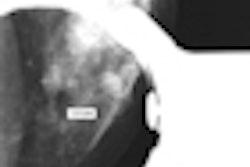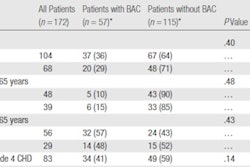A study published in the May issue of Radiology has identified set criteria that could be used to identify physicians who may benefit from additional training in interpreting screening mammograms.
Lead investigator Patricia Carney, Ph.D., from Oregon Health and Science University (OHSU) in Portland and colleagues conducted the study over eight months in 2009. They gathered a panel of 10 radiologists with mammography expertise from both academic and community-based practices to analyze performance data from hundreds of interpreting physicians across the U.S. (Radiology, May 2010, Vol. 255:2, pp. 354-361).
The researchers examined several measures that reflect interpretive accuracy, such as sensitivity, specificity, recall rate, and the positive predictive value of recall and of biopsy recommendations. The panel identified criteria, or "cut points," that targeted ranges of low-performance measures.
Carney's group found that as many as 18% to 28% of physicians interpreting screening mammography could benefit from additional training on the basis of sensitivity and cancer detection rate, and as many as 34% to 49% could benefit from additional training to improve specificity, recall, and the positive predictive value of recall and of biopsy recommendations.
If these underperforming physicians moved into what the expert panel deemed an acceptable range of interpretation performance, detection of an additional 14 cancers per 100,000 women via screening and a reduction in the number of false-positive exams by 880 per 100,000 women could be expected, the authors wrote.
They acknowledged that one of the study's weaknesses was that it could not take into account the specifics of how the cut points can be applied in actual practice: Performance measures may differ in high-risk populations or for initial screening examinations versus subsequent screening exams.
In a statement released by OHSU, Carney cautioned that women should not be overly concerned about the study results.
"This is the first time anyone has identified criteria for low performance," she said, "but women having mammograms should not be overly concerned by these findings because every mammography facility has a designated physician who is charged with monitoring available performance measures."
She suggested that all women should talk to their physicians about their concerns regarding screening mammograms and their personal risk factors for breast cancer, and if they have any concerns, based upon their risk, they should ask for a second interpreter to look at the film.
By Kate Madden Yee
AuntMinnie.com staff writer
April 23, 2010
Related Reading
FFDM magnification causes problems with lesion measurement, February 2, 2010
Digital mammography transition: The hidden issues, June 4, 2009
Digital mammography transition: The agony and the ecstasy, May 5, 2009
Digital mammograms take longer to read, study suggests, January 6, 2009
Copyright © 2010 AuntMinnie.com



















